Business Planning and Market Segmentation: A Comprehensive Report
VerifiedAdded on 2020/06/06
|8
|1952
|45
Report
AI Summary
This report provides a comprehensive overview of key business concepts, including the importance of planning and setting objectives for business organizations. It emphasizes the role of planning in guiding managers toward achieving goals and optimizing resource utilization. The report delves into the significance of setting specific, measurable, attainable, relevant, and time-bound (SMART) goals, which are crucial for motivating employees and directing business activities. Furthermore, it explores market segmentation strategies, detailing demographic, geographic, psychographic, and behavioral segmentation methods to understand customer needs. The report also discusses various types of teams, including permanent, temporary, task force, and self-managed teams, highlighting the issues that can arise in virtual teams, such as lack of coordination and technical challenges. The conclusion reinforces the importance of effective planning, goal setting, and teamwork for enhancing business productivity and efficiency.

Introduction to
Business
Business
Paraphrase This Document
Need a fresh take? Get an instant paraphrase of this document with our AI Paraphraser

Table of Contents
INTRODUCTION...........................................................................................................................1
Question 1 .......................................................................................................................................1
Question 2........................................................................................................................................2
Question 3........................................................................................................................................3
Question 4........................................................................................................................................4
CONCLUSION................................................................................................................................5
REFERENCES................................................................................................................................6
INTRODUCTION...........................................................................................................................1
Question 1 .......................................................................................................................................1
Question 2........................................................................................................................................2
Question 3........................................................................................................................................3
Question 4........................................................................................................................................4
CONCLUSION................................................................................................................................5
REFERENCES................................................................................................................................6
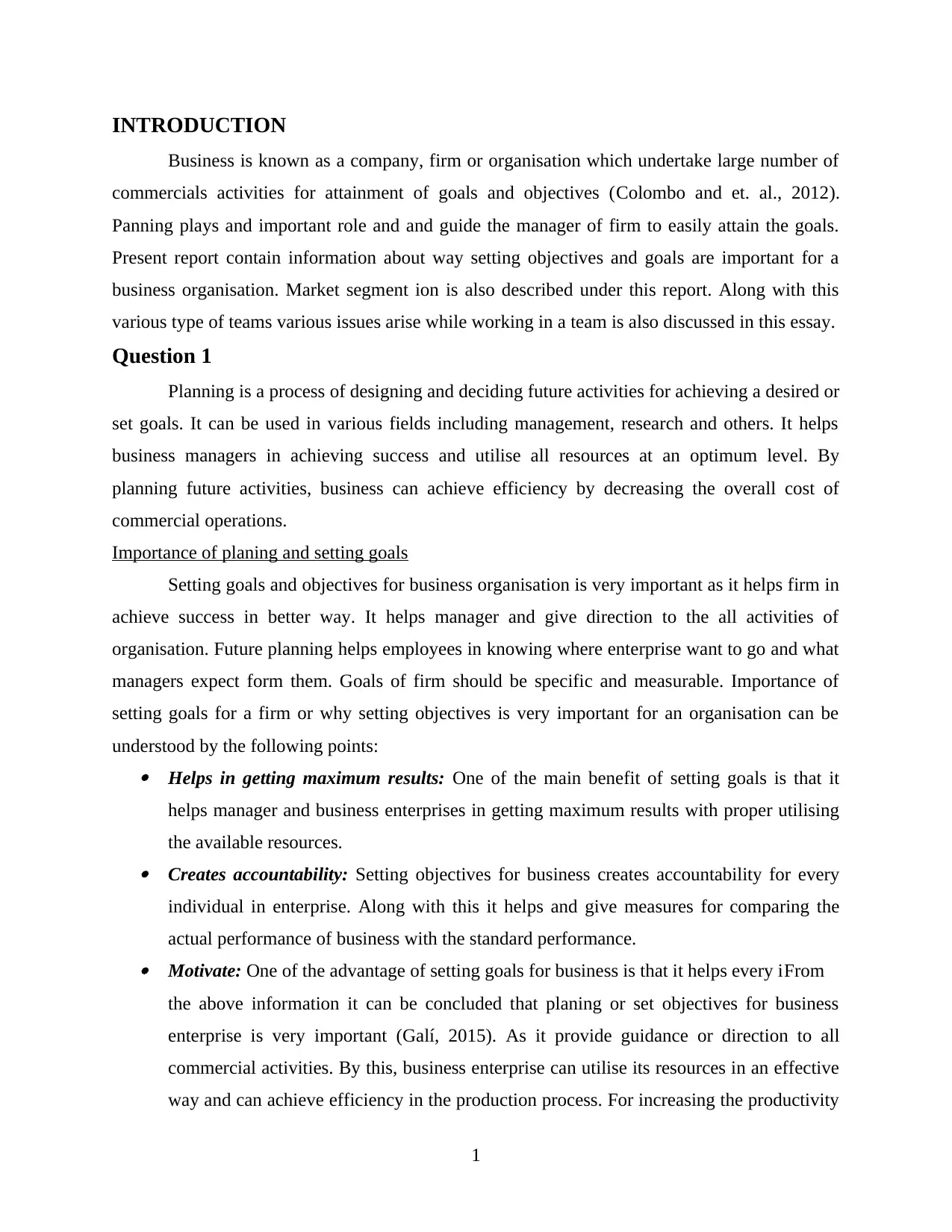
INTRODUCTION
Business is known as a company, firm or organisation which undertake large number of
commercials activities for attainment of goals and objectives (Colombo and et. al., 2012).
Panning plays and important role and and guide the manager of firm to easily attain the goals.
Present report contain information about way setting objectives and goals are important for a
business organisation. Market segment ion is also described under this report. Along with this
various type of teams various issues arise while working in a team is also discussed in this essay.
Question 1
Planning is a process of designing and deciding future activities for achieving a desired or
set goals. It can be used in various fields including management, research and others. It helps
business managers in achieving success and utilise all resources at an optimum level. By
planning future activities, business can achieve efficiency by decreasing the overall cost of
commercial operations.
Importance of planing and setting goals
Setting goals and objectives for business organisation is very important as it helps firm in
achieve success in better way. It helps manager and give direction to the all activities of
organisation. Future planning helps employees in knowing where enterprise want to go and what
managers expect form them. Goals of firm should be specific and measurable. Importance of
setting goals for a firm or why setting objectives is very important for an organisation can be
understood by the following points: Helps in getting maximum results: One of the main benefit of setting goals is that it
helps manager and business enterprises in getting maximum results with proper utilising
the available resources. Creates accountability: Setting objectives for business creates accountability for every
individual in enterprise. Along with this it helps and give measures for comparing the
actual performance of business with the standard performance. Motivate: One of the advantage of setting goals for business is that it helps every iFrom
the above information it can be concluded that planing or set objectives for business
enterprise is very important (Galí, 2015). As it provide guidance or direction to all
commercial activities. By this, business enterprise can utilise its resources in an effective
way and can achieve efficiency in the production process. For increasing the productivity
1
Business is known as a company, firm or organisation which undertake large number of
commercials activities for attainment of goals and objectives (Colombo and et. al., 2012).
Panning plays and important role and and guide the manager of firm to easily attain the goals.
Present report contain information about way setting objectives and goals are important for a
business organisation. Market segment ion is also described under this report. Along with this
various type of teams various issues arise while working in a team is also discussed in this essay.
Question 1
Planning is a process of designing and deciding future activities for achieving a desired or
set goals. It can be used in various fields including management, research and others. It helps
business managers in achieving success and utilise all resources at an optimum level. By
planning future activities, business can achieve efficiency by decreasing the overall cost of
commercial operations.
Importance of planing and setting goals
Setting goals and objectives for business organisation is very important as it helps firm in
achieve success in better way. It helps manager and give direction to the all activities of
organisation. Future planning helps employees in knowing where enterprise want to go and what
managers expect form them. Goals of firm should be specific and measurable. Importance of
setting goals for a firm or why setting objectives is very important for an organisation can be
understood by the following points: Helps in getting maximum results: One of the main benefit of setting goals is that it
helps manager and business enterprises in getting maximum results with proper utilising
the available resources. Creates accountability: Setting objectives for business creates accountability for every
individual in enterprise. Along with this it helps and give measures for comparing the
actual performance of business with the standard performance. Motivate: One of the advantage of setting goals for business is that it helps every iFrom
the above information it can be concluded that planing or set objectives for business
enterprise is very important (Galí, 2015). As it provide guidance or direction to all
commercial activities. By this, business enterprise can utilise its resources in an effective
way and can achieve efficiency in the production process. For increasing the productivity
1
⊘ This is a preview!⊘
Do you want full access?
Subscribe today to unlock all pages.

Trusted by 1+ million students worldwide
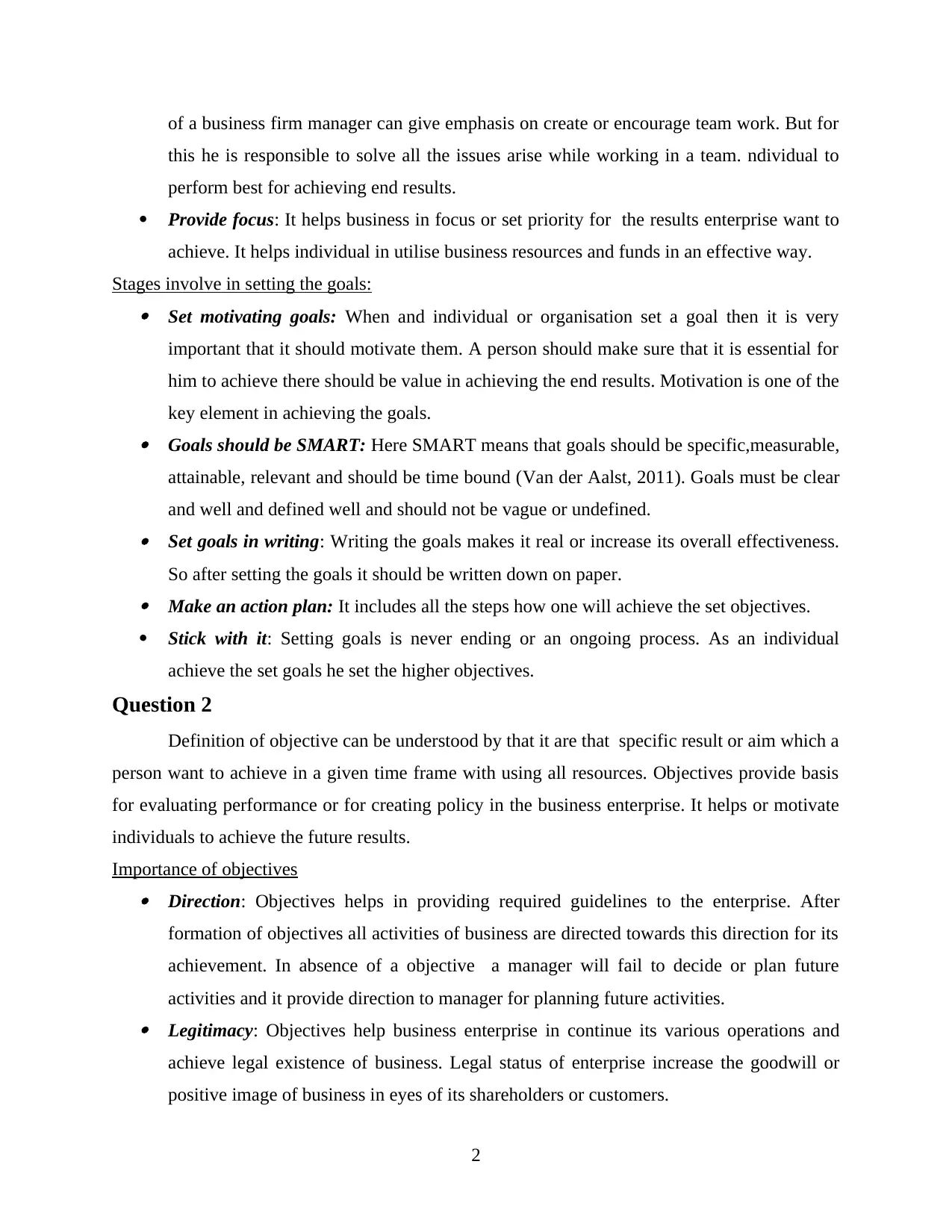
of a business firm manager can give emphasis on create or encourage team work. But for
this he is responsible to solve all the issues arise while working in a team. ndividual to
perform best for achieving end results.
Provide focus: It helps business in focus or set priority for the results enterprise want to
achieve. It helps individual in utilise business resources and funds in an effective way.
Stages involve in setting the goals: Set motivating goals: When and individual or organisation set a goal then it is very
important that it should motivate them. A person should make sure that it is essential for
him to achieve there should be value in achieving the end results. Motivation is one of the
key element in achieving the goals. Goals should be SMART: Here SMART means that goals should be specific,measurable,
attainable, relevant and should be time bound (Van der Aalst, 2011). Goals must be clear
and well and defined well and should not be vague or undefined. Set goals in writing: Writing the goals makes it real or increase its overall effectiveness.
So after setting the goals it should be written down on paper. Make an action plan: It includes all the steps how one will achieve the set objectives.
Stick with it: Setting goals is never ending or an ongoing process. As an individual
achieve the set goals he set the higher objectives.
Question 2
Definition of objective can be understood by that it are that specific result or aim which a
person want to achieve in a given time frame with using all resources. Objectives provide basis
for evaluating performance or for creating policy in the business enterprise. It helps or motivate
individuals to achieve the future results.
Importance of objectives Direction: Objectives helps in providing required guidelines to the enterprise. After
formation of objectives all activities of business are directed towards this direction for its
achievement. In absence of a objective a manager will fail to decide or plan future
activities and it provide direction to manager for planning future activities. Legitimacy: Objectives help business enterprise in continue its various operations and
achieve legal existence of business. Legal status of enterprise increase the goodwill or
positive image of business in eyes of its shareholders or customers.
2
this he is responsible to solve all the issues arise while working in a team. ndividual to
perform best for achieving end results.
Provide focus: It helps business in focus or set priority for the results enterprise want to
achieve. It helps individual in utilise business resources and funds in an effective way.
Stages involve in setting the goals: Set motivating goals: When and individual or organisation set a goal then it is very
important that it should motivate them. A person should make sure that it is essential for
him to achieve there should be value in achieving the end results. Motivation is one of the
key element in achieving the goals. Goals should be SMART: Here SMART means that goals should be specific,measurable,
attainable, relevant and should be time bound (Van der Aalst, 2011). Goals must be clear
and well and defined well and should not be vague or undefined. Set goals in writing: Writing the goals makes it real or increase its overall effectiveness.
So after setting the goals it should be written down on paper. Make an action plan: It includes all the steps how one will achieve the set objectives.
Stick with it: Setting goals is never ending or an ongoing process. As an individual
achieve the set goals he set the higher objectives.
Question 2
Definition of objective can be understood by that it are that specific result or aim which a
person want to achieve in a given time frame with using all resources. Objectives provide basis
for evaluating performance or for creating policy in the business enterprise. It helps or motivate
individuals to achieve the future results.
Importance of objectives Direction: Objectives helps in providing required guidelines to the enterprise. After
formation of objectives all activities of business are directed towards this direction for its
achievement. In absence of a objective a manager will fail to decide or plan future
activities and it provide direction to manager for planning future activities. Legitimacy: Objectives help business enterprise in continue its various operations and
achieve legal existence of business. Legal status of enterprise increase the goodwill or
positive image of business in eyes of its shareholders or customers.
2
Paraphrase This Document
Need a fresh take? Get an instant paraphrase of this document with our AI Paraphraser
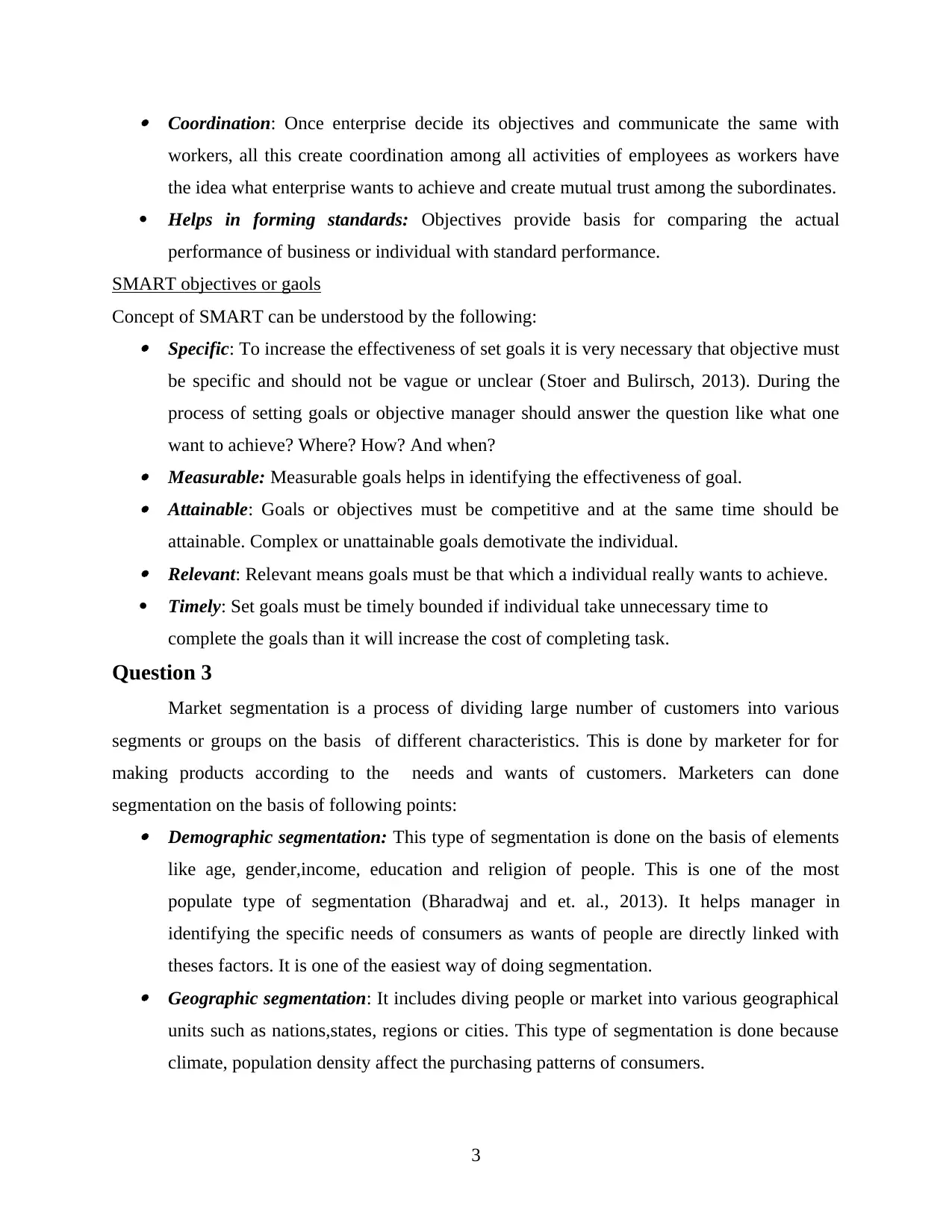
Coordination: Once enterprise decide its objectives and communicate the same with
workers, all this create coordination among all activities of employees as workers have
the idea what enterprise wants to achieve and create mutual trust among the subordinates.
Helps in forming standards: Objectives provide basis for comparing the actual
performance of business or individual with standard performance.
SMART objectives or gaols
Concept of SMART can be understood by the following: Specific: To increase the effectiveness of set goals it is very necessary that objective must
be specific and should not be vague or unclear (Stoer and Bulirsch, 2013). During the
process of setting goals or objective manager should answer the question like what one
want to achieve? Where? How? And when? Measurable: Measurable goals helps in identifying the effectiveness of goal. Attainable: Goals or objectives must be competitive and at the same time should be
attainable. Complex or unattainable goals demotivate the individual. Relevant: Relevant means goals must be that which a individual really wants to achieve.
Timely: Set goals must be timely bounded if individual take unnecessary time to
complete the goals than it will increase the cost of completing task.
Question 3
Market segmentation is a process of dividing large number of customers into various
segments or groups on the basis of different characteristics. This is done by marketer for for
making products according to the needs and wants of customers. Marketers can done
segmentation on the basis of following points: Demographic segmentation: This type of segmentation is done on the basis of elements
like age, gender,income, education and religion of people. This is one of the most
populate type of segmentation (Bharadwaj and et. al., 2013). It helps manager in
identifying the specific needs of consumers as wants of people are directly linked with
theses factors. It is one of the easiest way of doing segmentation. Geographic segmentation: It includes diving people or market into various geographical
units such as nations,states, regions or cities. This type of segmentation is done because
climate, population density affect the purchasing patterns of consumers.
3
workers, all this create coordination among all activities of employees as workers have
the idea what enterprise wants to achieve and create mutual trust among the subordinates.
Helps in forming standards: Objectives provide basis for comparing the actual
performance of business or individual with standard performance.
SMART objectives or gaols
Concept of SMART can be understood by the following: Specific: To increase the effectiveness of set goals it is very necessary that objective must
be specific and should not be vague or unclear (Stoer and Bulirsch, 2013). During the
process of setting goals or objective manager should answer the question like what one
want to achieve? Where? How? And when? Measurable: Measurable goals helps in identifying the effectiveness of goal. Attainable: Goals or objectives must be competitive and at the same time should be
attainable. Complex or unattainable goals demotivate the individual. Relevant: Relevant means goals must be that which a individual really wants to achieve.
Timely: Set goals must be timely bounded if individual take unnecessary time to
complete the goals than it will increase the cost of completing task.
Question 3
Market segmentation is a process of dividing large number of customers into various
segments or groups on the basis of different characteristics. This is done by marketer for for
making products according to the needs and wants of customers. Marketers can done
segmentation on the basis of following points: Demographic segmentation: This type of segmentation is done on the basis of elements
like age, gender,income, education and religion of people. This is one of the most
populate type of segmentation (Bharadwaj and et. al., 2013). It helps manager in
identifying the specific needs of consumers as wants of people are directly linked with
theses factors. It is one of the easiest way of doing segmentation. Geographic segmentation: It includes diving people or market into various geographical
units such as nations,states, regions or cities. This type of segmentation is done because
climate, population density affect the purchasing patterns of consumers.
3
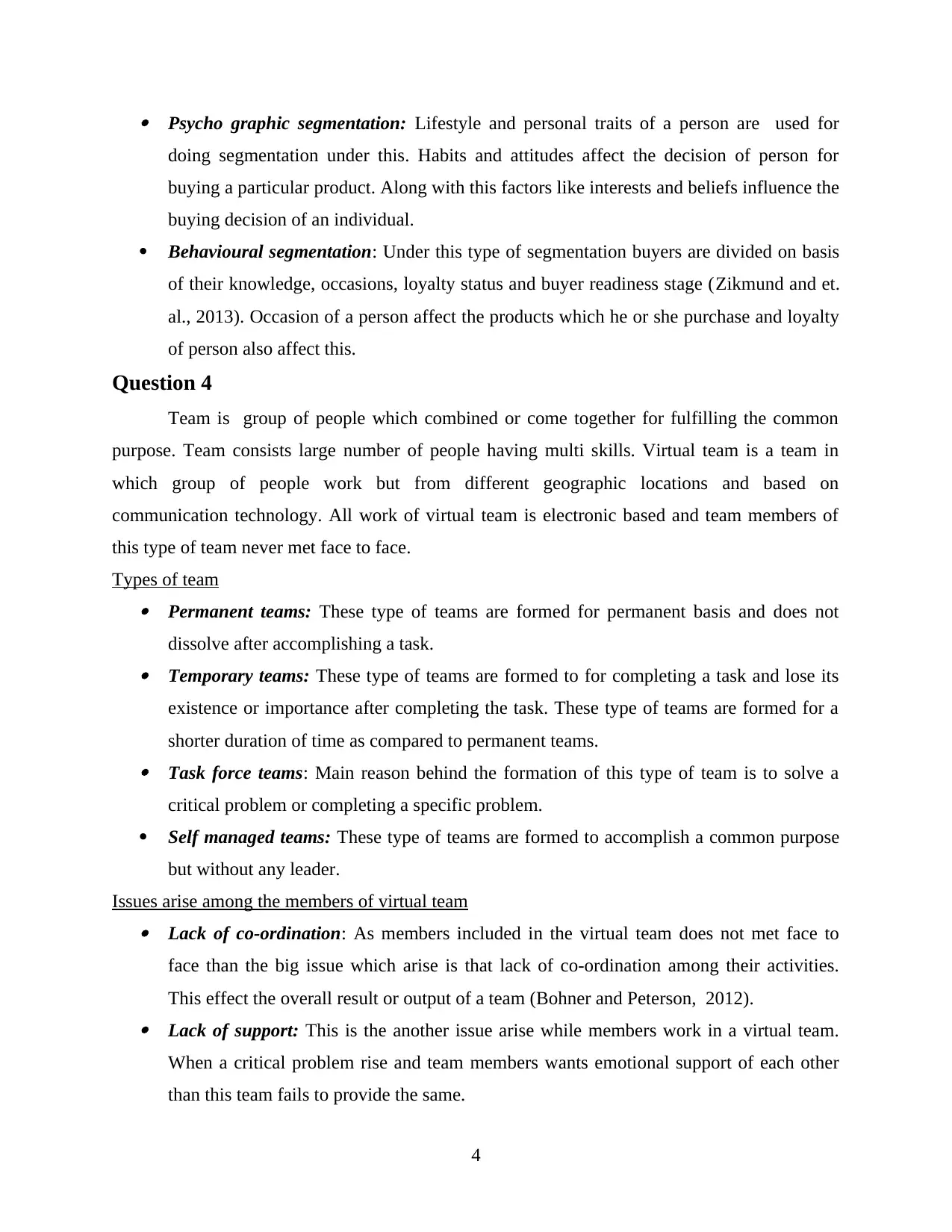
Psycho graphic segmentation: Lifestyle and personal traits of a person are used for
doing segmentation under this. Habits and attitudes affect the decision of person for
buying a particular product. Along with this factors like interests and beliefs influence the
buying decision of an individual.
Behavioural segmentation: Under this type of segmentation buyers are divided on basis
of their knowledge, occasions, loyalty status and buyer readiness stage (Zikmund and et.
al., 2013). Occasion of a person affect the products which he or she purchase and loyalty
of person also affect this.
Question 4
Team is group of people which combined or come together for fulfilling the common
purpose. Team consists large number of people having multi skills. Virtual team is a team in
which group of people work but from different geographic locations and based on
communication technology. All work of virtual team is electronic based and team members of
this type of team never met face to face.
Types of team Permanent teams: These type of teams are formed for permanent basis and does not
dissolve after accomplishing a task. Temporary teams: These type of teams are formed to for completing a task and lose its
existence or importance after completing the task. These type of teams are formed for a
shorter duration of time as compared to permanent teams. Task force teams: Main reason behind the formation of this type of team is to solve a
critical problem or completing a specific problem.
Self managed teams: These type of teams are formed to accomplish a common purpose
but without any leader.
Issues arise among the members of virtual team Lack of co-ordination: As members included in the virtual team does not met face to
face than the big issue which arise is that lack of co-ordination among their activities.
This effect the overall result or output of a team (Bohner and Peterson, 2012). Lack of support: This is the another issue arise while members work in a virtual team.
When a critical problem rise and team members wants emotional support of each other
than this team fails to provide the same.
4
doing segmentation under this. Habits and attitudes affect the decision of person for
buying a particular product. Along with this factors like interests and beliefs influence the
buying decision of an individual.
Behavioural segmentation: Under this type of segmentation buyers are divided on basis
of their knowledge, occasions, loyalty status and buyer readiness stage (Zikmund and et.
al., 2013). Occasion of a person affect the products which he or she purchase and loyalty
of person also affect this.
Question 4
Team is group of people which combined or come together for fulfilling the common
purpose. Team consists large number of people having multi skills. Virtual team is a team in
which group of people work but from different geographic locations and based on
communication technology. All work of virtual team is electronic based and team members of
this type of team never met face to face.
Types of team Permanent teams: These type of teams are formed for permanent basis and does not
dissolve after accomplishing a task. Temporary teams: These type of teams are formed to for completing a task and lose its
existence or importance after completing the task. These type of teams are formed for a
shorter duration of time as compared to permanent teams. Task force teams: Main reason behind the formation of this type of team is to solve a
critical problem or completing a specific problem.
Self managed teams: These type of teams are formed to accomplish a common purpose
but without any leader.
Issues arise among the members of virtual team Lack of co-ordination: As members included in the virtual team does not met face to
face than the big issue which arise is that lack of co-ordination among their activities.
This effect the overall result or output of a team (Bohner and Peterson, 2012). Lack of support: This is the another issue arise while members work in a virtual team.
When a critical problem rise and team members wants emotional support of each other
than this team fails to provide the same.
4
⊘ This is a preview!⊘
Do you want full access?
Subscribe today to unlock all pages.

Trusted by 1+ million students worldwide
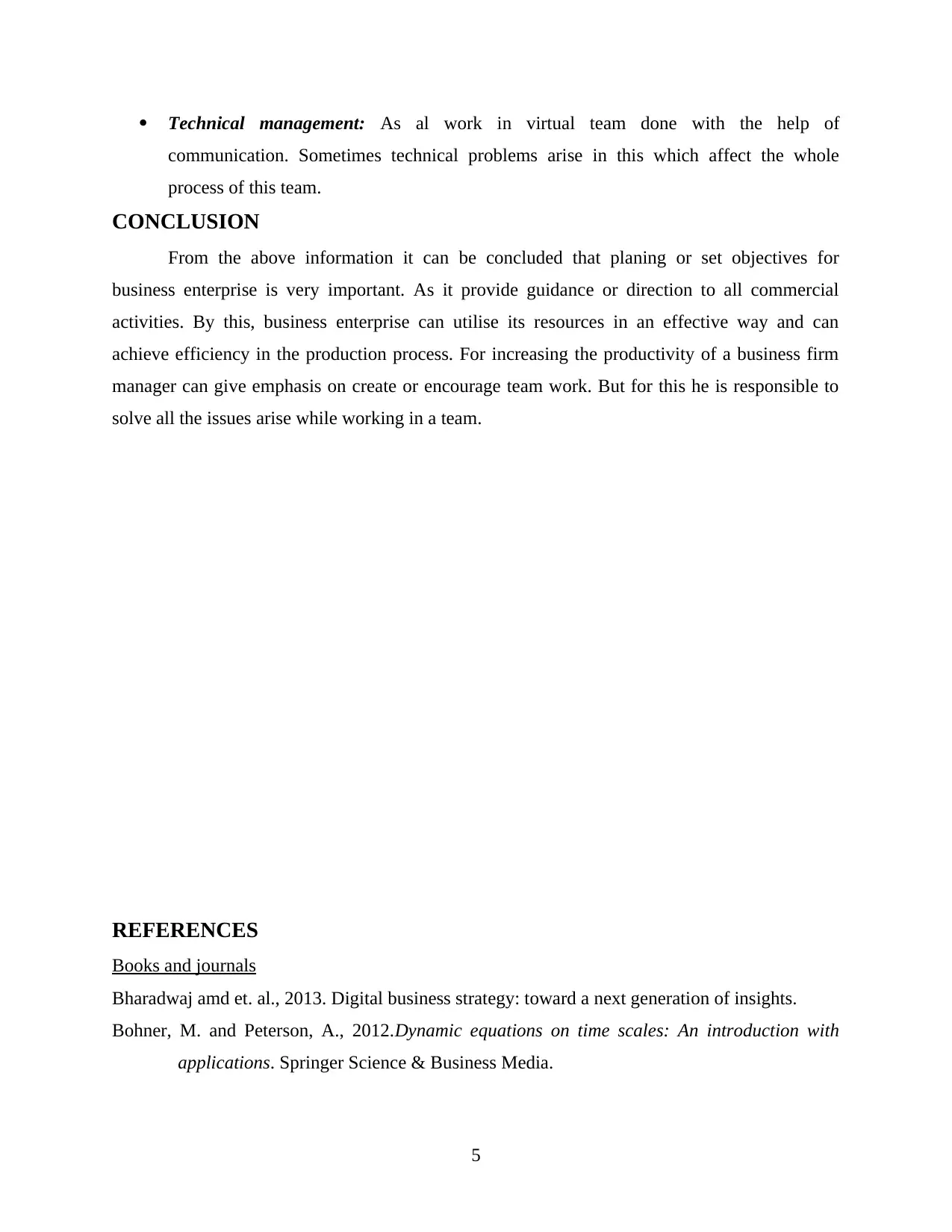
Technical management: As al work in virtual team done with the help of
communication. Sometimes technical problems arise in this which affect the whole
process of this team.
CONCLUSION
From the above information it can be concluded that planing or set objectives for
business enterprise is very important. As it provide guidance or direction to all commercial
activities. By this, business enterprise can utilise its resources in an effective way and can
achieve efficiency in the production process. For increasing the productivity of a business firm
manager can give emphasis on create or encourage team work. But for this he is responsible to
solve all the issues arise while working in a team.
REFERENCES
Books and journals
Bharadwaj amd et. al., 2013. Digital business strategy: toward a next generation of insights.
Bohner, M. and Peterson, A., 2012.Dynamic equations on time scales: An introduction with
applications. Springer Science & Business Media.
5
communication. Sometimes technical problems arise in this which affect the whole
process of this team.
CONCLUSION
From the above information it can be concluded that planing or set objectives for
business enterprise is very important. As it provide guidance or direction to all commercial
activities. By this, business enterprise can utilise its resources in an effective way and can
achieve efficiency in the production process. For increasing the productivity of a business firm
manager can give emphasis on create or encourage team work. But for this he is responsible to
solve all the issues arise while working in a team.
REFERENCES
Books and journals
Bharadwaj amd et. al., 2013. Digital business strategy: toward a next generation of insights.
Bohner, M. and Peterson, A., 2012.Dynamic equations on time scales: An introduction with
applications. Springer Science & Business Media.
5
Paraphrase This Document
Need a fresh take? Get an instant paraphrase of this document with our AI Paraphraser
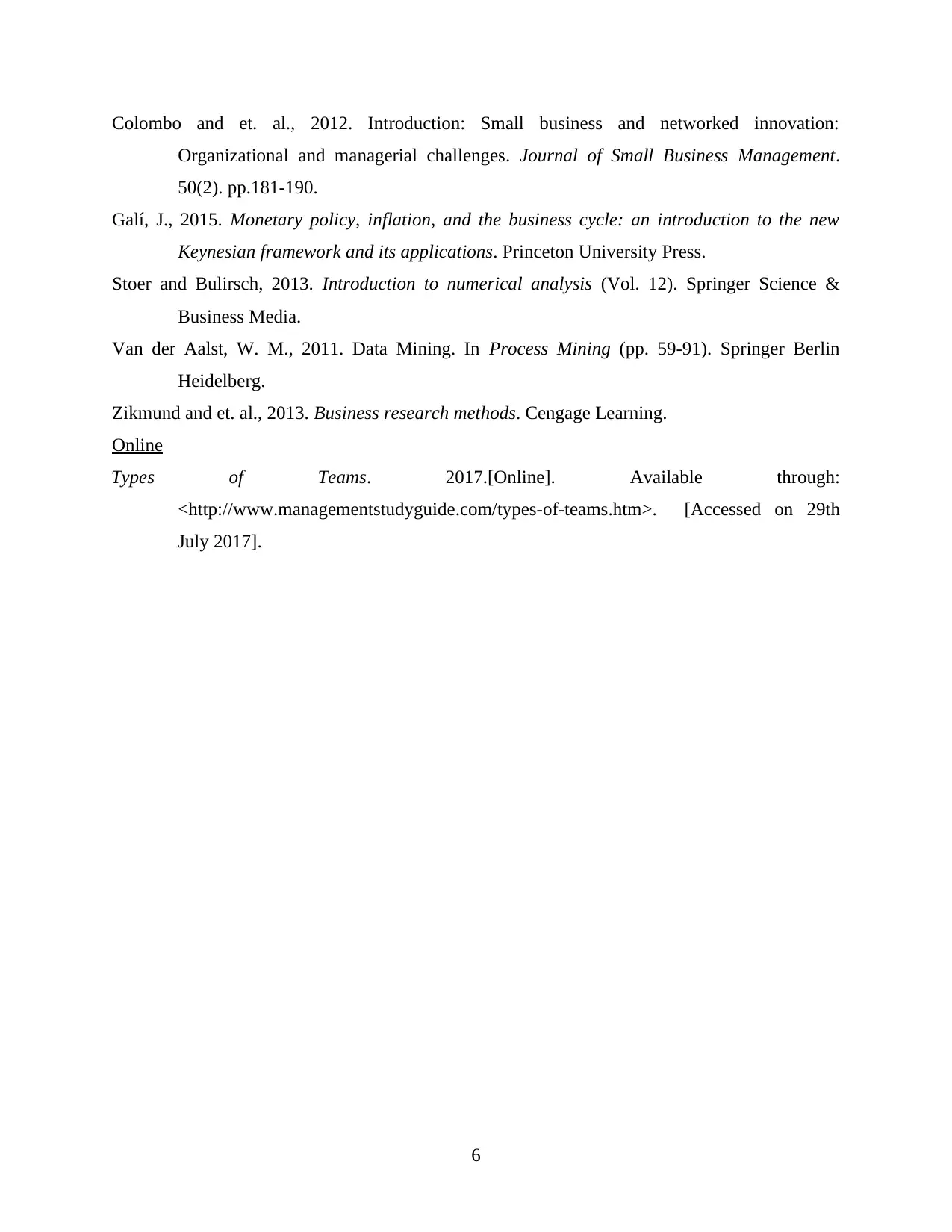
Colombo and et. al., 2012. Introduction: Small business and networked innovation:
Organizational and managerial challenges. Journal of Small Business Management.
50(2). pp.181-190.
Galí, J., 2015. Monetary policy, inflation, and the business cycle: an introduction to the new
Keynesian framework and its applications. Princeton University Press.
Stoer and Bulirsch, 2013. Introduction to numerical analysis (Vol. 12). Springer Science &
Business Media.
Van der Aalst, W. M., 2011. Data Mining. In Process Mining (pp. 59-91). Springer Berlin
Heidelberg.
Zikmund and et. al., 2013. Business research methods. Cengage Learning.
Online
Types of Teams. 2017.[Online]. Available through:
<http://www.managementstudyguide.com/types-of-teams.htm>. [Accessed on 29th
July 2017].
6
Organizational and managerial challenges. Journal of Small Business Management.
50(2). pp.181-190.
Galí, J., 2015. Monetary policy, inflation, and the business cycle: an introduction to the new
Keynesian framework and its applications. Princeton University Press.
Stoer and Bulirsch, 2013. Introduction to numerical analysis (Vol. 12). Springer Science &
Business Media.
Van der Aalst, W. M., 2011. Data Mining. In Process Mining (pp. 59-91). Springer Berlin
Heidelberg.
Zikmund and et. al., 2013. Business research methods. Cengage Learning.
Online
Types of Teams. 2017.[Online]. Available through:
<http://www.managementstudyguide.com/types-of-teams.htm>. [Accessed on 29th
July 2017].
6
1 out of 8
Related Documents
Your All-in-One AI-Powered Toolkit for Academic Success.
+13062052269
info@desklib.com
Available 24*7 on WhatsApp / Email
![[object Object]](/_next/static/media/star-bottom.7253800d.svg)
Unlock your academic potential
Copyright © 2020–2025 A2Z Services. All Rights Reserved. Developed and managed by ZUCOL.





